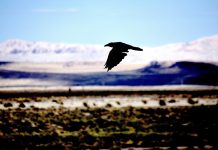AUSTIN, Texas, July 11 (UPI) — New research suggests closed-mouth sounds made by modern birds may be analogous to dinosaur vocalization.
Dinos might have been tight-lipped cooers and mumblers, not ferocious open-mouthed roarers as they’re often depicted in film.
“Looking at the distribution of closed-mouth vocalization in birds that are alive today could tell us how dinosaurs vocalized,” Chad Eliason, a postdoctoral researcher at The University of Texas Jackson School of Geosciences, said in a news release.
Birds are primarily known as singers and callers. But many species also make sounds with their beaks closed, emitting softer, low-pitched sounds through their necks.
Many city dwellers would recognize this type of vocalization as the type cooing pigeon doves employ as they line up along the edges of rooftops.
Many other other bird species use similar coos and grumbles to attract mates or warn away those encroaching on their territory. A significant amount of lung pressure is required to inflate the elastic cavity that powers closed-beak reverberations, which means the technique is employed almost exclusively by larger bird species.
In terms of evolution, however, the technique is rather accessible.
“A cool thing about this work is the demonstration that closed-mouth behavior evolved many times,” said Tobias Riede, a physiology professor at Midwestern University. “That suggests it can emerge fairly easily and be incorporated into mating displays.”
Riede is the first author of a new paper on the research, published this week in the journal Evolution.
Although there remains no fossil evidence revealing what dinosaurs sounded like, researchers say their latest efforts suggest a more dynamic aural landscape during the Jurassic Period. If both birds and crocodiles use closed-mouth vocalizations, it’s likely some of their ancestors did as well.
“To make any kind of sense of what nonavian dinosaurs sounded like, we need to understand how living birds vocalize,” said Julia Clarke, a professor at the Jackson School of Geosciences. “This makes for a very different Jurassic world. Not only were dinosaurs feathered, but they may have had bulging necks and made booming, closed-mouth sounds.”






